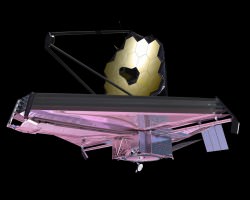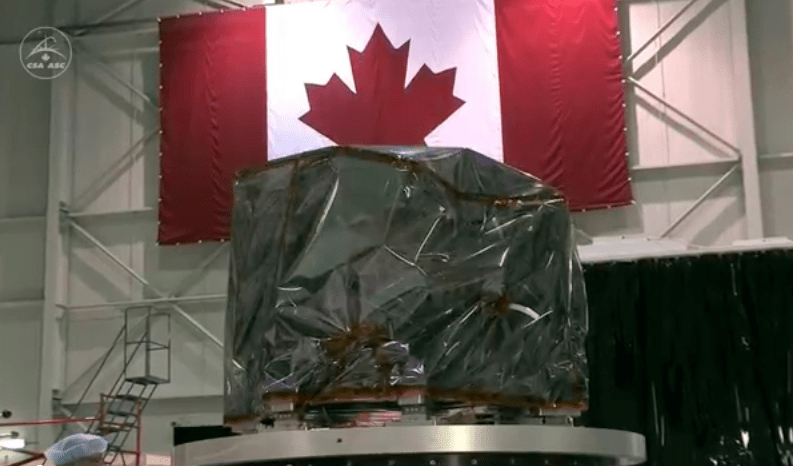Today Canada’s Minister of Industry Christian Paradis unveiled the technologies that comprise Canada’s contribution to the James Webb Space Telescope, a next-generation infrared observatory that’s seen as the successor to Hubble.
CSA will provide JWST with a two-in-one instrument: a Fine Guidance Sensor (FGS) Near-Infrared Imager and Slitless Spectrograph (NIRISS). Both were designed, built and tested by COM DEV International in Ottawa and Cambridge, Ontario, with technical contributions from the Université de Montréal and the National Research Council Canada.
Read: Watch the James Webb Being Built via “Webb-Cam”
“Canada has a proud legacy in space and we are once again pushing the frontier of what is possible. These two outstanding technologies are perfect examples of how Canada has secured its world-class reputation. Our Government is committed to ensuring the long-term competitiveness and prosperity of such a vital economic sector.”
– The Honourable Christian Paradis
 The FGS consists of two identical cameras that are critical to Webb’s ability to “see.” Their images will allow the telescope to determine its position, locate its celestial targets, and remain pointed to collect high-quality data. The FGS will guide the telescope with incredible precision, with an accuracy of one millionth of a degree.
The FGS consists of two identical cameras that are critical to Webb’s ability to “see.” Their images will allow the telescope to determine its position, locate its celestial targets, and remain pointed to collect high-quality data. The FGS will guide the telescope with incredible precision, with an accuracy of one millionth of a degree.
The NIRISS will have unique capabilities for finding the earliest and most distant objects in the Universe’s history. It will also peer through the glare of nearby young stars to unveil new Jupiter-like exoplanets. It will have the capability of detecting the thin atmosphere of small, habitable, earth-like planets and determine its chemical composition to seek water vapour, carbon dioxide and other potential biomarkers such as methane and oxygen.
The FGS/NIRISS instruments can be seen in this development video from CSA:
“Imagine the challenge at hand here: to design and deliver technology capable of unprecedented levels of precision to conduct breakthrough science on board the largest, most complex and most powerful telescope ever built,” said Steve MacLean, President of the CSA. “The Webb telescope will be located 1.5 million kilometers from Earth— too far to be serviced by astronauts like Hubble was. At that distance, the technology simply has to work. This is the outstanding level of excellence Canadians are capable of achieving. It’s something for all of us to be proud of.”
The instruments will be delivered to NASA on July 30.
Read more on the CSA press release here, and learn more about the James Webb here.
Images/video: CSA and NASA


Is it better than Sidney Crosby? :d
“The Webb telescope will be located 1.5 million kilometers from Earth— too far to be serviced by astronauts like Hubble was…”
Looking into a crystal skull (? – LOL), I wonder when the first manned mission to satellites at the Lagrangian points will be? Maybe Elan has something to say about a service like that?
Actually… I’m a proponent of a *.sat rejuvenation and re tasking program. Modify your orbit Mister? There are so many underutilized or abandoned on-orbit resources available – known or assumed. Hey! That stuff’s already out there in orbit! A “price buster”? The possible elemental contributions include rare earth metals, light weight structures and rad hardened electronic components. Now, if we were to salvage and reuse some of the orbital debris.. would it be hubris? or panache?
How about building a Lagrange mission spacecraft from some of those assets?
I don’t think the economics of orbital repair has been demonstrated.
– The worth of most of the components is nothing compared to the cost of putting them in orbit. And launching the fuel needed for an orbital repair craft may make the net negative.
– Specific radiation resistant technology components (say, JFETS) may be needed for radiation intensive environments like around the gas giants. For LEO/GEO/NEO crafts it is likely sufficient with “top of breed” components, the chips that tests with fewest errors are also the ones that withstand radiation best and age slowest.
But they age, and so it is more appropriate to call them “rad damaged”. Reusing them will only get you so much.
That said I think there is something to say about Lagrange missions. The post on Mars transfer technologies must have been inundated with comments because its commentary is closed while the few comments have racked up an impressive interest. That is too bad, because it touches on this:
NASA plans for Earth-Moon L2 Lagrange point missions, which are of similar worth as Webb’s Sun-Earth L2 missions. The reason is that an ISS derived Gateway is a staging post for NEO, or SEL2, missions as well as a platform for developing crafts using ISS modules and a commercial Solar Electric Propulsion (SEP) system.
Such systems could make LEO/GEO/EML2/SEL2 repair missions economically feasible. It would also develop the SEP technology more, which is the system that looks closest to be used for NEO & Mars missions.
Propulsion technologies are already diverging between low thrust SEP systems for robotic exploration or manned mission automated payloads (say, depots and return crafts for Mars missions pre-delivered in orbit by using fuel saving Lagrange points transfer aka Interplanetary Highway) and high thrust SEP systems for manned missions.
Aerojet’s SEP uses Hall thrusters, what I know of. Nested Hall thrusters could surpass VASIMR in performance. So I think we are good for Lagrange missions, and it could be interesting targets scientifically if not of the import that asteroids are. What junk do they amass and for how long time does it stay there?
“I don’t think the economics of orbital repair has been demonstrated.” Umm, how many missions went out to repair the Hubble Space Telescope? How much was that worth? Also in 1984 shuttle astronauts repaired the Solar Max *.sat. So the technology is there…. and the economics would rely on what’s worth salvaging.
Where I’m going with this.. salvage large antenna arrays, solar arrays, and support structures – there have been several ‘bus sized’ NSA snoop missions! (Telecommunications intercept) Some of those now defunct missions used expanding truss systems for structural support. Those truss sections when combined with modifications and joined to other structures could hold a mobile ‘Dexter-like’ robot, ion engines, spare parts and tools and…. a habitat module mounted on a centrifuge?
The real problem would be to find out WHAT is out there and then gathering the engineering specs for all the potential targets. Also determining which vehicles are too dangerous to approach – left over propellant or excessive rotation due to outgassing? etc.
Missions could be planned for consecutive visits within an orbital range of objects – meaning that extreme orbital corrections could be avoided? The GEO *.sats mostly orbit in the same plane.. somewhat simplifying rendezvous…. if we could get out there!
You could have launched a brand new Hubble every year for the cost of operating the shuttle that year. Hubble servicing was only cost-effective because Hubble didn’t pay for it.
As for salvaging, maybe, but the bottom line is that if there were solid gold ingots orbiting the Earth, we don’t have launch technology cheap enough to make it worth retrieving them.
I was assessing general repair.
And see Kevin’s comment for Hubble. The political pressure was for proving that the Shuttle concept was legitimate when it wasn’t.
Oh, jeez!
This is great, eh?
wooow! this telescope is going to be great! Im also really glad about that donated spy satellite too!
If Webb will surpass Spitzer, it will do great things.
But it must suck to wait another 6 years before your delivered instruments launch. “If there are sure facts in astronomy, it is the expansion of the universe and of NASA’s project costs.”